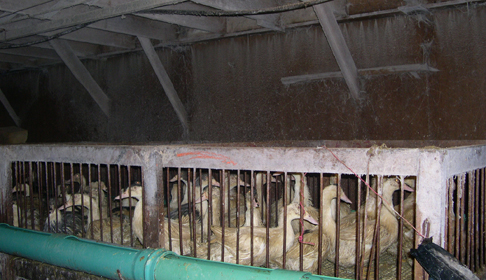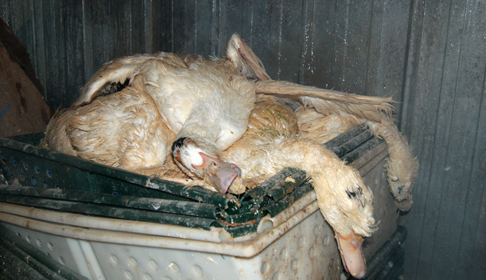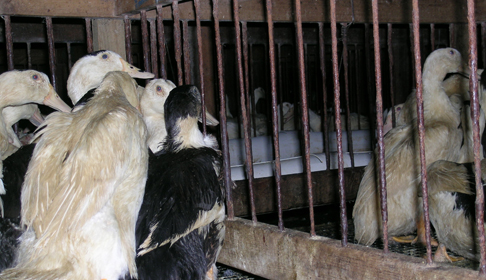An interview with Bruce Friedrich, Senior Policy Director
– Staff writer
On July 1, 2012, after an eight-year waiting period, California became the first U.S. state to outlaw the production of foie gras and the only place in the world where its sale is illegal. This development was a milestone for Farm Sanctuary and our allies; we have been fighting to draw attention to the horrible abuse involved in foie gras production for decades.
French for “fatty liver,” foie gras is the diseased, fat-engorged liver of a duck or goose. Foie gras producers force-feed their birds large quantities of corn and fat by thrusting a metal tube down their throats and pumping meal directly into their stomachs two to three times a day for several weeks. At the end of this period, with livers swollen eight to ten times the normal size, the birds who have not already died from collateral injuries or ailments are slaughtered.
We sat down with Senior Policy Director Bruce Friedrich and National Shelter Director Susie Coston to find out the essential information about the industry, its victims and survivors, and the progress we’re making to end this incredibly cruel practice. In Part 1, Bruce fills us in on the issues.
What are the main challenges facing opponents of foie gras production?
Relatively few ducks are raised for foie gras compared to the numbers of hens used for eggs and chickens for meat. Many people have never even heard of foie gras, and those who have heard of it often aren’t aware of the cruelty involved in production.

Inside a foie gras facility.
What are some of the arguments put forward by proponents of foie gras, and how do you respond to these?
The most common defense is to talk in general terms about “freedom” and the “choice” to eat whatever we please. The second most common argument is to point out the abuses that occur in other food industries and to claim that banning foie gras represents class discrimination in that it primarily affects the wealthy, who are its predominant consumers. Foie gras proponents also argue that ducks naturally gorge themselves and that force-feeding, therefore, mimics nature.
We reframe the “freedom” and “choice” argument from abstract language to specific. Everyone generally supports individual freedoms, but almost no one thinks that you should be able to choose to abuse dogs and cats. When we speak specifically about the abuse foie gras entails, most consumers agree with us that it should be illegal. Few people think it’s acceptable to cram pipes down animals’ throats and to induce a horribly painful disease — and that’s what foie gras does and is.
Regarding class discrimination, we point out that this rationale is simply an attempt to avoid the issue. People who are unwilling to discuss the reality of the actual practices of foie gras are in a pretty sorry rhetorical position. And, of course, supporters of foie gras bans oppose the worst abuses in all food industries, not just foie gras, including extreme confinement systems, inhumane methods of poultry slaughter, and many more.
Finally, on the issue of whether gorging is natural, we point to the overwhelming scientific evidence that indicates that it’s not natural for ducks and geese to eat so much that their livers swell to ten times their natural size. And, of course, in a natural environment, they don’t eat so much that their death rate rises, let alone skyrockets in the way it does during foie gras production. Force-fed ducks die at 10 to 20 times the rate of non-force-fed ducks, according to a European Union study — and that was in a controlled environment.
 Scientific studies have found that foie gras birds suffer from impaired liver function, skeletal disorders, and other serious illnesses. Many becoming so sick they can barely move. See this article for more on the scientific indictment of the foie gras industry.
Scientific studies have found that foie gras birds suffer from impaired liver function, skeletal disorders, and other serious illnesses. Many becoming so sick they can barely move. See this article for more on the scientific indictment of the foie gras industry.
Foie gras proponents also argue that ducks do not react aversely to force-feeding. That claim is belied by a large body of undercover video collected by multiple groups over the past two decades, which provides ample footage of ducks clearly struggling in pain as the pipes are thrust down their throats.
Investigations have uncovered, among other horrors, cramped and filthy living conditions; ducks with gruesome, untreated injuries such as broken bills and neck wounds; ducks with organs damaged or ruptured by force-feeding; workers roughly handling and brutally killing ducks; and barrels full of dead ducks. This video, for example, was recorded by an investigator working undercover at one facility (be warned, it includes graphic footage of suffering and death).
 What is the current state of foie gras legislation and legal action nationally? Are there any bills pending?
What is the current state of foie gras legislation and legal action nationally? Are there any bills pending?
Foie gras is banned in California, and we are working with our friends at the Animal Legal Defense Fund and Compassion Over Killing (COK) on a national solution by suing the United States Department of Agriculture (USDA) to ban foie gras based on the Poultry Products Inspection Act (PPIA). Under PPIA, the USDA is responsible for condemning products derived from diseased birds, which foie gras ducks and geese certainly are. Hepatic lipidosis, the condition purposefully induced by force-feeding, is a disease.
Has the California ban proved effective? Are chefs defying it or exploiting loopholes to a significant degree?
The ban has been very effective. Although a few chefs are having temper tantrums and attempting to skirt the law (for instance, by giving foie gras away instead of selling it), the vast majority of places that offered it before no longer do. And, the one foie gras producer in California — one of three in the nation — has ceased foie gras production altogether.
Does the implementation of the California ban pave the way for bans elsewhere?
We are hopeful that California’s move will be the end of foie gras in the United States. Our friends at the Animal Legal Defense Fund and Animal Protection and Rescue League, in particular, are doing some great work to relegate this product of torture to the dust bin of history. California was the number one market for foie gras in this country by far. The state has taken a powerful stance that will continue to resonate.
In Part 2, Susie Coston introduces some of the ducks of Farm Sanctuary who have found refuge from the foie gras industry, including Harper and Kohl, Monet and Matisse, and three of our newest residents: Ellen, Carrie, Emily, and Kristen. She describes the gentle care they receive to treat their sick and abused bodies and to overcome their tremendous fear of humans.
